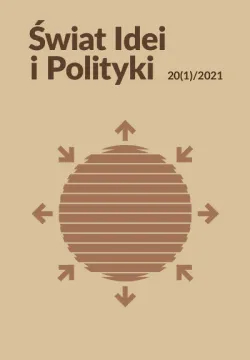Metaphor in the analysis and evaluation of a complexsecurity environment
DOI:
https://doi.org/10.34767/SIIP.2021.01.10Keywords:
metaphor, environment, safety, design, objectives, complexityAbstract
The paper presents research on the possibilities resulting from the use of metaphor in the process of identifying, analyzing and assessing selected categories of the complex security environment and determining the directions of development of the problem situation. The results of the research were obtained using a questionnaire in the frame of the experiment. Participants were students of War Studies University who underwent a process of education in the field of alternative methods of analyzing and assessing the environment and designing activities with the use of the armed forces. The research process included an experiment in which the results of the work of teams conducting environmental assessments were compared. The scope of the metaphor’s application was presented among the many tools of project teams’ work. The results of the research suggest that building a metaphor in the process of analyzing and assessing the security environment facilitates the determination of directions for the development of a problem situation. This effect is achieved by identifying objectives and end states of the actors in a given problem situation. The results of the research can be applied in those areas of practical activity that relate to the design of assumptions for the operation of specific forces and means. The adopted process of environmental analysis and assessment is aimed at obtaining a holistic picture of reality. This is a response to the need for a general understanding of the problem situation, identification of objectives of the entities to this situation and the specificity of the entities involved in a given problem situation.
References
Balcerowicz, B. (2002). Pokój i Nie-Pokój. Na progu XXI wieku. Warszawa: Dom Wydawniczy Bellona.
Bógdał-Brzezińska, A. (2001). Kategoria globalizacji w nauce o stosunkach międzynarodowych. Stosunki Międzynarodowe, 1–2.
Huntington, S.P. (2004). Zderzenie cywilizacji. Warszawa: Warszawskie Wydawnictwo Literackie Muza.
Jung, C.G. (2007). Four Archetypes. Londyn–Nowy Jork: Routledge Classics.
Lawson, B. (2006). How Designer Think: The Design Process Demystified. Amsterdam: Elsevier.
Perkins, D.G. (2017). Multi – Domain Battle. Driving Change to Win in the Future. Military Review, lipiec-sierpień.
Schön, D. (1983). The Reflective Practitioner: How Professionals Think in Action. New York: Basic Books.
Snowden, D.J. & Boone, M.E., (2007). A leader’s framework for decision making. Harvard Business Review, listopad.
Toffler, A. & Toffler H. (1997). Wojna i antywojna. Warszawa: Warszawskie Wydawnictwo Literackie MUZA SA.
Zacher L.W. (2018). Długofalowe trendy rozwoju społeczeństwa informacyjnego. Roczniki Kolegium Analiz Ekonomicznych. Warszawa: SGH.
Dokumenty pochodzące z Archiwów Instytutu Pamięci Narodowej:
Sygn. BU 0662/1:
Porozumienie o współpracy pomiędzy organami bezpieczeństwa ZSRR i PRL, 12 stycznia 1957 r., k. 5–9.
Porozumienie o współpracy organów bezpieczeństwa PRL i ZSRR, 27 listopada 1975 r., k. 16–21.
Organizacja i zakres pracy Grupy Kontrwywiadowczej Departamentu II MSW kryptonim „Wisła”, brak daty dziennej, październik 1974 r., k. 62–66.
Notatka dotycząca ustanowienia przedstawicielstwa MSW PRL przy MSW ZSRR i jego zadań, brak daty dziennej, grudzień 1982 r., k. 78–84.
Sygn. BU 01062/43/7:
Pismo do Pierwszego Zastępcy Ministra Bezpieczeństwa Państwowego NRD Berlin, 28 czerwca 1956 r., k. 30–32.
Dane uzupełniające do notatki z dn. 4 września 1956 r., k. 42–48.
Sygn. BU 01062/33 t. I:
Notatka dot. zasad organizacji pracy grupy operacyjnej Departamentu II MSW na terenie Bułgarii w czasie od 23 VI – 20 IX 1963 r., 26 maja 1964 r., k. 26–31.
Notatka służbowa dot. spraw, które zostaną podniesione przez stronę bułgarską, 13 września 1965 r., k. 52–53.
Raport skierowany do Dyrektora Departamentu II MSW płk. R. Matejewskiego dotyczy działalności grupy operacyjnej kryptonim „ODRA” na terenie BRL, 29 września 1964 r., k. 57–80.
Notatka dotycząca realizacji przez Departament II umowy zawartej między MSW PRL i organami bezpieczeństwa BRL, brak daty dziennej, wrzesień 1965 r., k. 81–85.
Sygn. BU 0811/87:
Notatka z rozmów przeprowadzonych pomiędzy pracownikami MSW CSRS i MSW PRL, czerwiec 1963 r., k. 1.
Sygn. BU 0655/10:
Protokół o głównych kierunkach rozwoju współpracy pomiędzy Departamentem II MSW PRL i Departamentem III/II MSW WRL, październik 1984 r., k. 2–6.
Sygn. BU 01062/48/8:
Instrukcja dla Podgrupy Departamentu II Rezydentury Berlińskiej, 23 stycznia 1968 r., k. 47–50.
Instrukcja dla pionu kontrwywiadowczego Rezydentury Berlińskiej, 7 listopada 1964 r., k. 108–112;
Sygn. BU 0662/6:
Sprawozdanie z pracy operacyjnej w Leningradzie za okres od 1 stycznia 1975 r. do 30 listopada 1976 r., 1 grudnia 1976 r., k. 3–14.
Sygn. BU 0662/5:
Kierunkowy plan działania, 31 sierpnia 1978 r., k. 2–5.
Downloads
Published
Issue
Section
License

This work is licensed under a Creative Commons Attribution-NonCommercial-NoDerivatives 4.0 International License.

